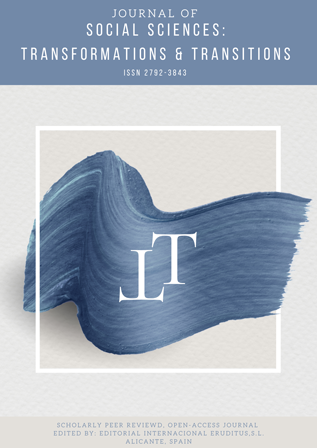Impact of Human Development Indicators on Child Mortality: The Case Study of Iran
DOI:
https://doi.org/10.52459/josstt23200422Keywords:
Human development Index, Under-Five Mortality, Unemployment, Inflation, Income Distribution Inequality, IranAbstract
The mortality rate of children under the age of five is of particular importance, as it is often related to the general level of health and living standard condition of the household in the society. The study aimed to investigate the effects of the Human Development Index on public health with particular reference to the under-five mortality rate in Iran. As a method a descriptive-analytical method including ordinary least square regression analysis was used to identify the causal relationship between the human development index and the under-five mortality rate during the period of the study (1987-2017) in Iran. The results show that there is a negative and meaningful relationship between the human development index (HDI) level and the under-five mortality rate. Moreover, the control variables including inflation rate, unemployment rate, and income distribution inequality index showed a positive and meaningful impact on the under-five mortality rate. Given that human capital is considered the engine of economic growth and development, it can be concluded that any increase in health expenditures through improvements in human capital inventory leads to increased economic growth, increased life expectancy, and decreased under-five mortality rate.
Metrics
References
Al-Haq, M. (1995). Reflections on Human Development. New York, Oxford University Press.
Alvarez, J.L., Gil, R., Hernandez, V and Gil, A. (2009). Factors associated with maternal mortality in sub-Saharan Africa: an ecological study. BMC public health. 9 (462); 1-20. 9 (462); 1-20. DOI: 10.1186/1471-2458-9-462.
Barnett, R. Tingzhong, Y. and Xiaozhao, Y. (2021). Smoking Environments in China; Challenges for Tobacco Control. Global Perspectives on Health, Springer Publication, Springer Nature, Switzerland. ISBN: 978-3-030-76143-1. DOI: 10.1007/978-3-030-76143-1.
Bjorke, S. (2017). Higher education impact on human development: A case study from Pakistan. Pakistan Journal of Education; 145-380. http://hdl.handle.net/11250/2459860 .
Bloom, D., Canning, D., and Sevilla, J. (2004). The effect of health on economic growth: A production function approach. World Development. 32(1); 1-13. DOI: 10.1016/j.worlddev.2003.07.002.
Bloom, D. E., and Canning, D. (2007). Commentary: The Preston Curve 30 years on: still sparking fires. International Journal of Epidemiology. 36(3); 498-499. DOI: 10.1093/ije/dym079.
Bloom, D., Canning, D., and Fink, G. (2014). Disease and development revisited. The Journal of Political Economy. 122(6); 1355–1366. DOI: 10.1086/677189.
Boachie, MK. (2017). Health and Economic Growth in Ghana: An Empirical Investigation. Journal of the Humanities and Social Sciences. 1.10(2); 253–65. DOI: 10.1007/s40647-016-0159-2.
Chakraborty, S. (2004). Endogenous lifetime and economic growth. Journal of Economic Theory .116(1); 119–37. DOI: 10.1016/j.jet.2003.07.005.
Detollenaere, J., and Desmarest, A., Boeckxstaens, P., Willems, S. (2018). The link between income inequality and health in Europe, adding strength dimensions of primary care to the equation. Social Science & Medicine Volume 201, March 2018; 103-110. DOI: 10.1016/j.socscimed.2018.01.041.
Frey RS, Field C. (2000).The determinants of infant mortality in the less developed countries: a cross-national test of five theories. Social Indicators Research. 2000 Dec. 52 (3); 215-234. DOI: 10.1023/A:1007093631977.
Fuchs, V. R. (1992). Poverty and health: asking the right questions. The American Economist. 36(2); 12-18. DOI: 10.1177/056943459203600202.
Grossman, M. (2000). The Human Capital Model. Hand Book of Health Economics, Chapter 7.1(A); 347-408. DOI: 10.1016/S1574-0064(00)80166-3.
Hajebi, E., Razmi, M.J. (2014). Effect of income inequality on health status in a selection of middle and low-income countries. Equilibrium. Quarterly Journal of Economics and Economic Policy, 9 (4); 133-152. DOI: 10.12775/EQUIL.2014.029.
Jahan, S. (2016). Human Development Report; Human Development for Everyone. United Nations Development Program (UNDP) .2017 Aug. eISBN: 978-92-1-060036-1. https://hdr.undp.org/sites/default/files/2016_human_development_report.pdf
Jonas, M ., Jørgen, H. and Simon, Ø. (2019). Association of Household Income with Life Expectancy and Cause-Specific Mortality in Norway, 2005-2015. Journal Summaries in Internal Medicine. 321(19); 1916-1925. DOI:10.1001/jama.2019.4329.
Klaus, K. and Tom, S. (2019). Social Inequality by Income in Short- and Long-Term Cause-Specific Mortality after Stroke. Journal of Stroke and Cerebrovascular Diseases. 28 (6); 1529-153. DOI: 10.1016/j.jstrokecerebrovasdis.2019.03.013.
Lee, K., Park, S., Khoshnood, B. Hsieh, H., and Mittendorf, R. (1997). Human Development Index as a predictor of infant and maternal mortality rates. The Journal of pediatrics. 131(3); 430-433. DOI:10.1016/S0022-3476(97)80070-4.
Lotfalipur, M., Falahi, M. and Borji, M. (2011). The effect of health indicators on economic growth in Iran. Journal of Health Administration. 14(46); 57-70. http://jha.iums.ac.ir/article-1-1024-en.html
Matthew, P. and Brodersen, D. (2018). Income inequality and health outcomes in the United States: An empirical analysis. The Social Science Journal. 55(4); 432-442. DOI: 10.1016/j.soscij.2018.05.001.
Ogundari, k. and Awokuse, T. (2018). Human capital contribution to economic growth in Sub-Saharan Africa: Does health status matter more than education? Economic Analysis and Policy. 58(C);131-140. DOI: 10.1016/j.eap.2018.02.001.
Rosendo Silva, F., Simões, M. and Sousa Andrade, J. (2018). Health investments and economic growth: a quantile regression approach. International Journal of Development. 17(2); 220–245. DOI: 10.1108/IJDI-12-2017-0200.
Subremanin, S.V., and Kwachi, I. (2004). Income Inequality and Health: What Have We Learned So Far? Epidemiology Review. 26(1); 78-91. DOI: 10.1093/epirev/mxh003.
Suri, T., Boozer, M.A., Ranis, G., and Stewart, F. (2011). The relationship between human development and economic growth. World Development. 7(2); 506-522.
DOI: 10.1016/j.worlddev.2010.08.020.
Webber, D. J. (2002). Polices to stimulate growth: Should we invest in health or education? Applied Economics. 34(13);1633.1643. DOI: 10.1080/00036840110115109.
WHO – World Health Organization (2019). Global Health Observatory (GHO) data, Child mortality, and causes of death. https://www.who.int/data/gho/data/themes/topics/topic-details/GHO/child-mortality-and-causes-of-death
Yakunina, R.and Bychkov, G. (2015). Correlation analysis of the components of the human development index across countries. Procedia Economics and Finance.24; 766-771. DOI: 10.1016/S2212-5671(15)00692-9.
Downloads
Published
Issue
Section
License
Copyright (c) 2022 Hamid SEPEHRDOUST, Maede TORKAMANI, Sadra SEPEHRDOUST, Arad SOLGI, Arian SOLGI

This work is licensed under a Creative Commons Attribution 4.0 International License.









